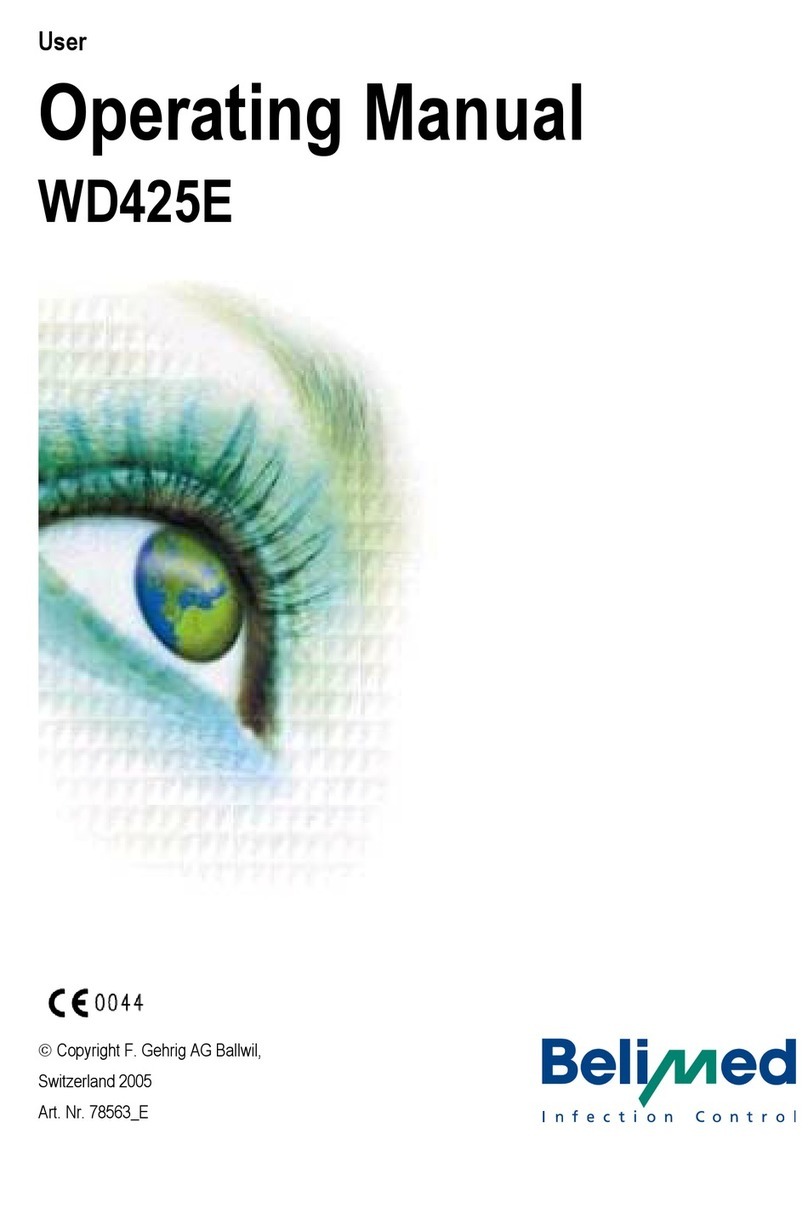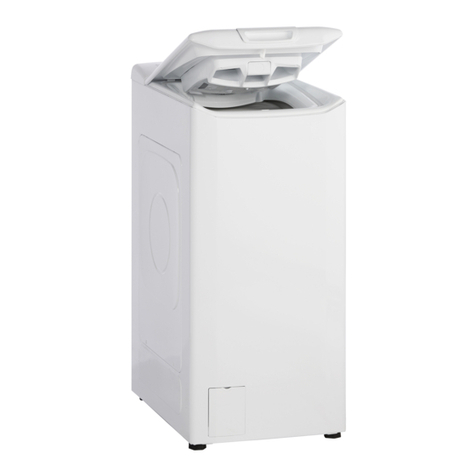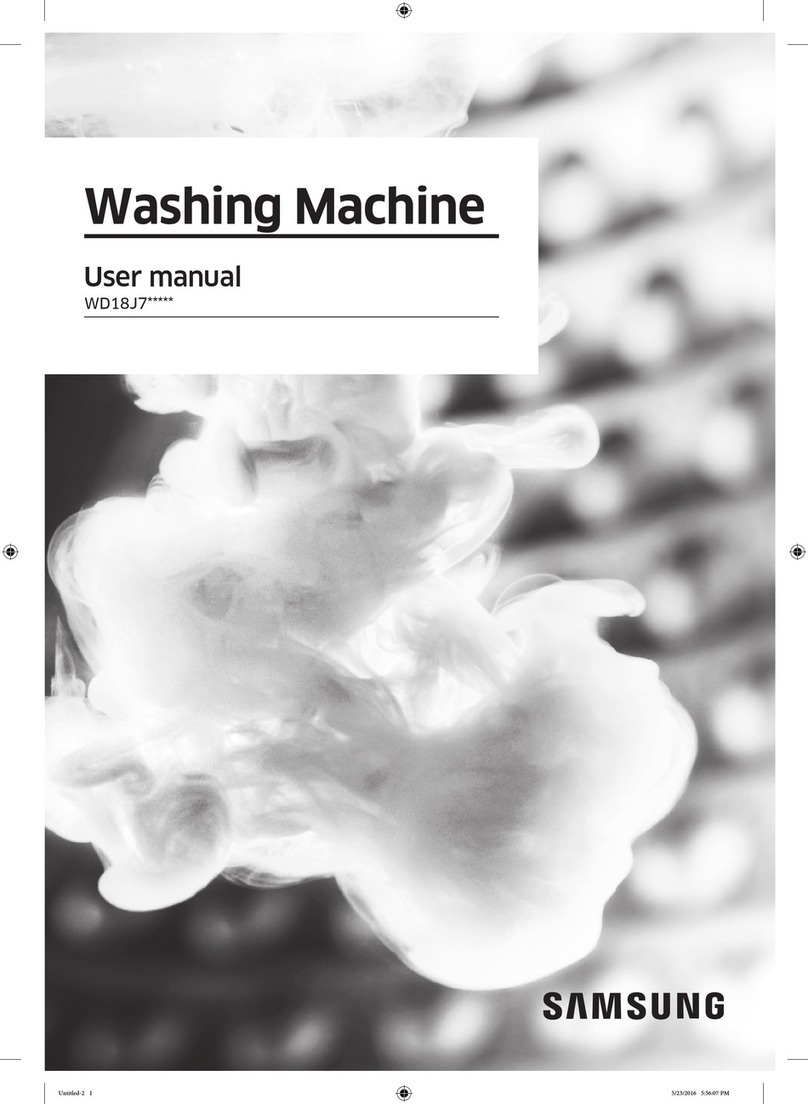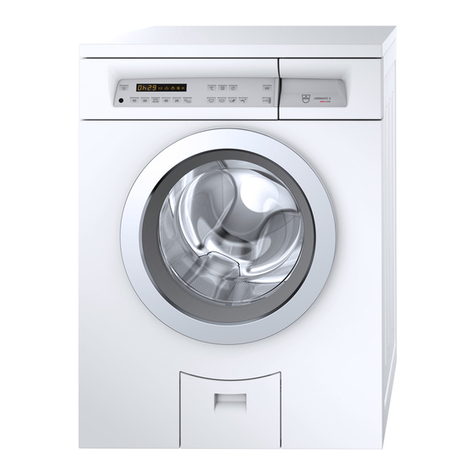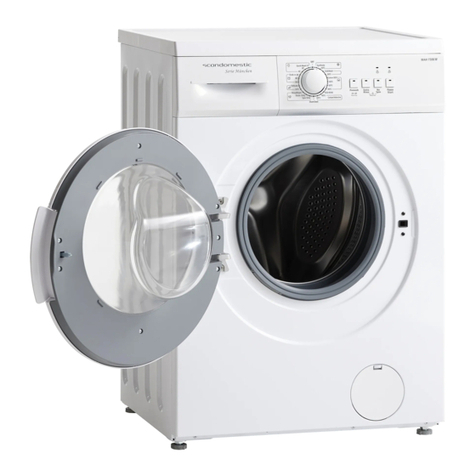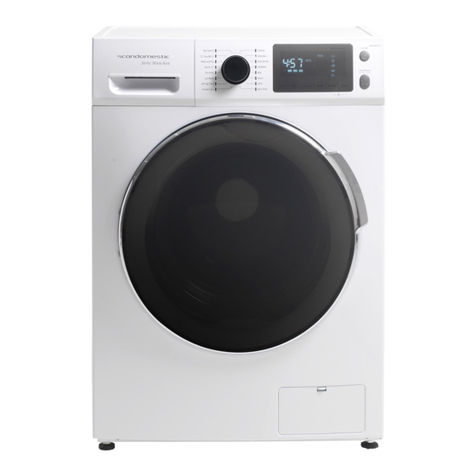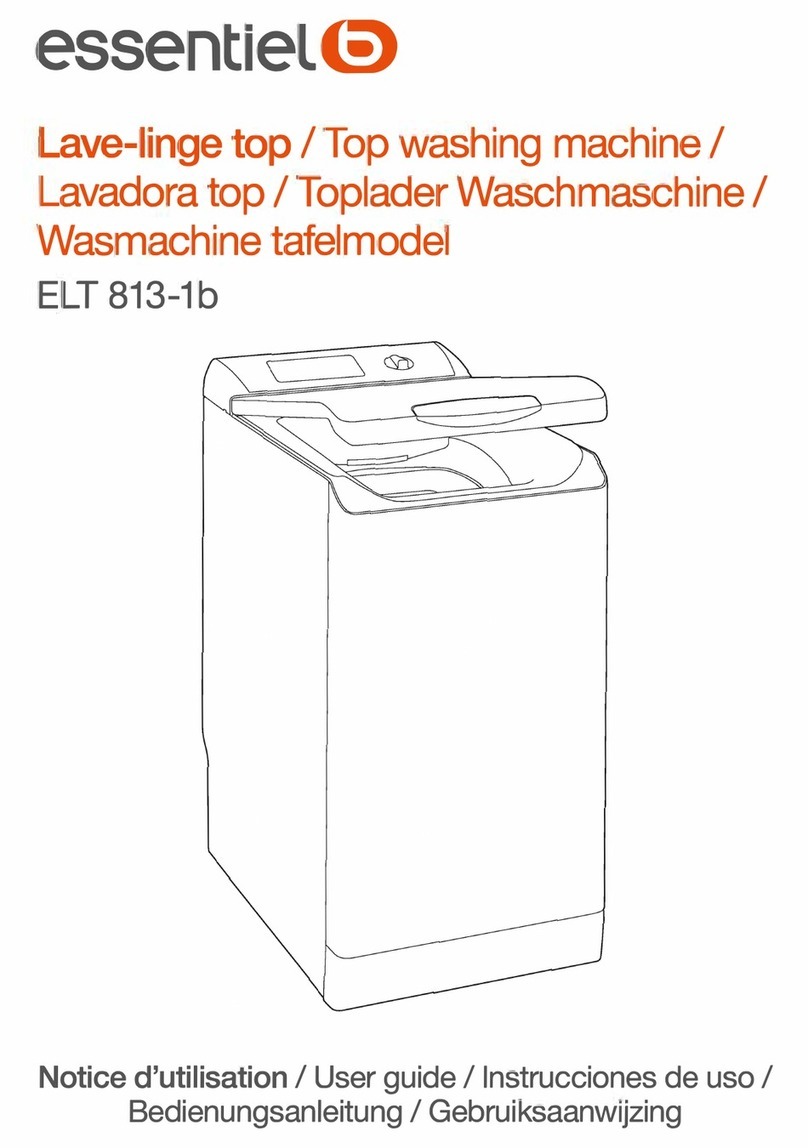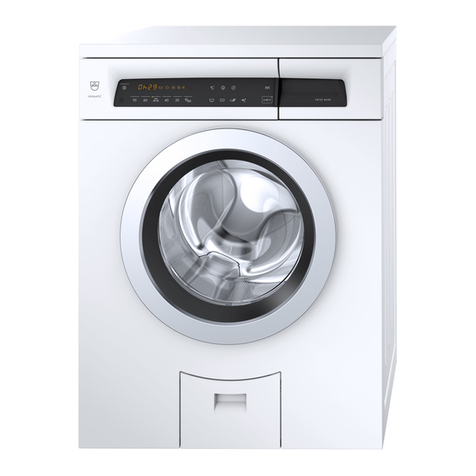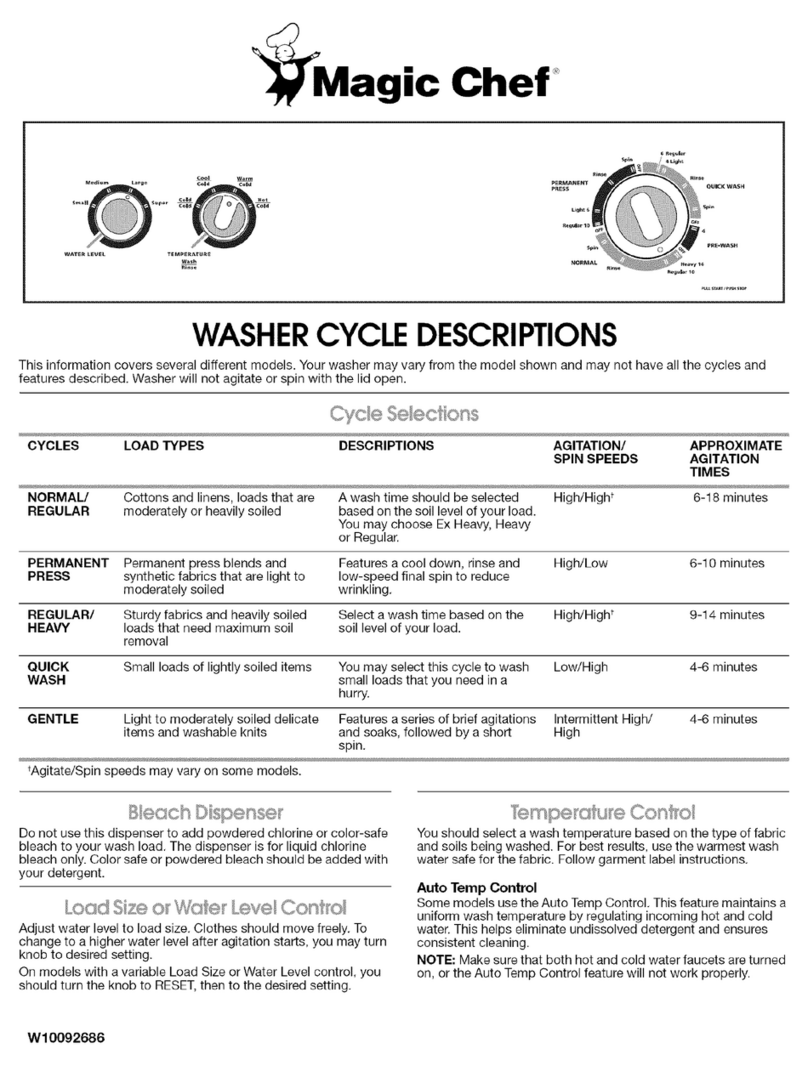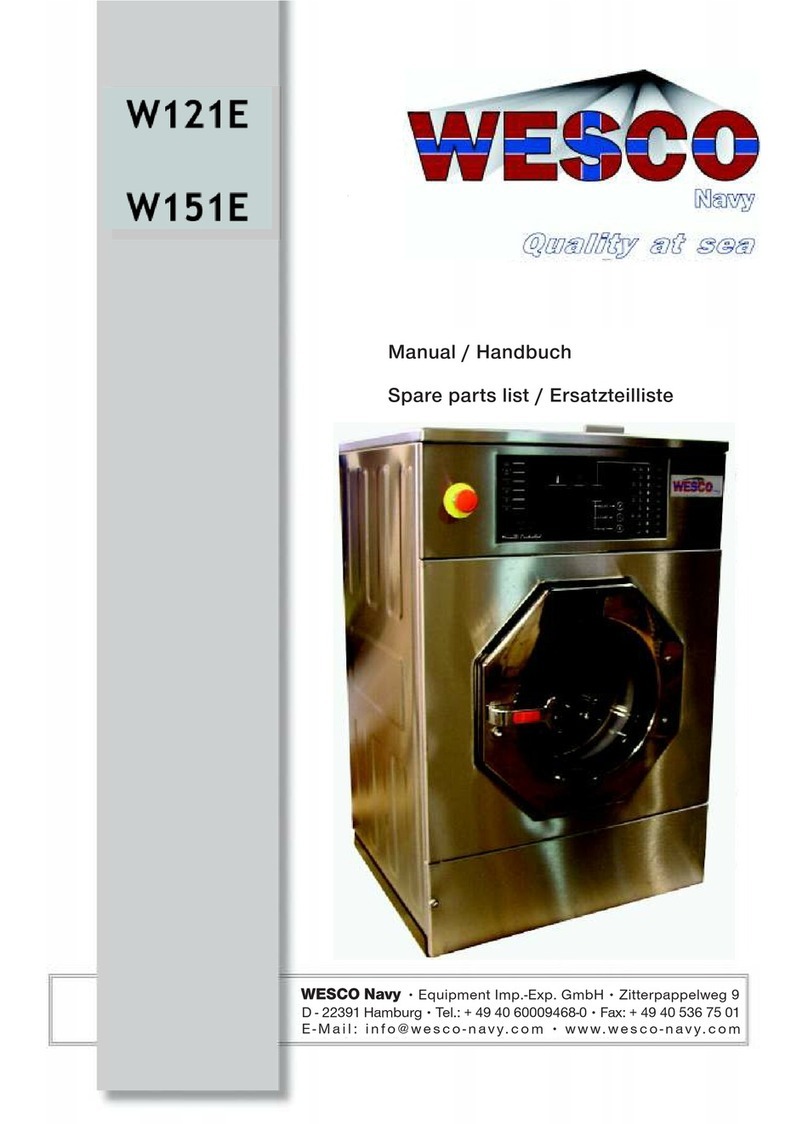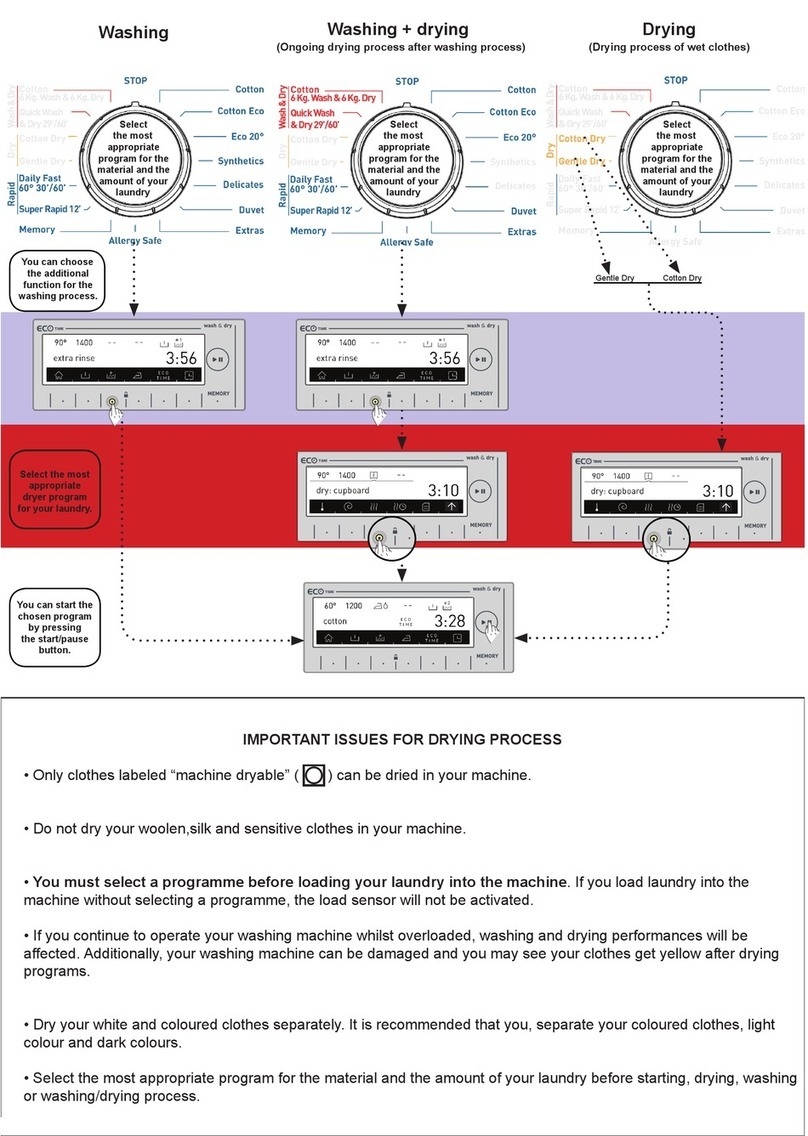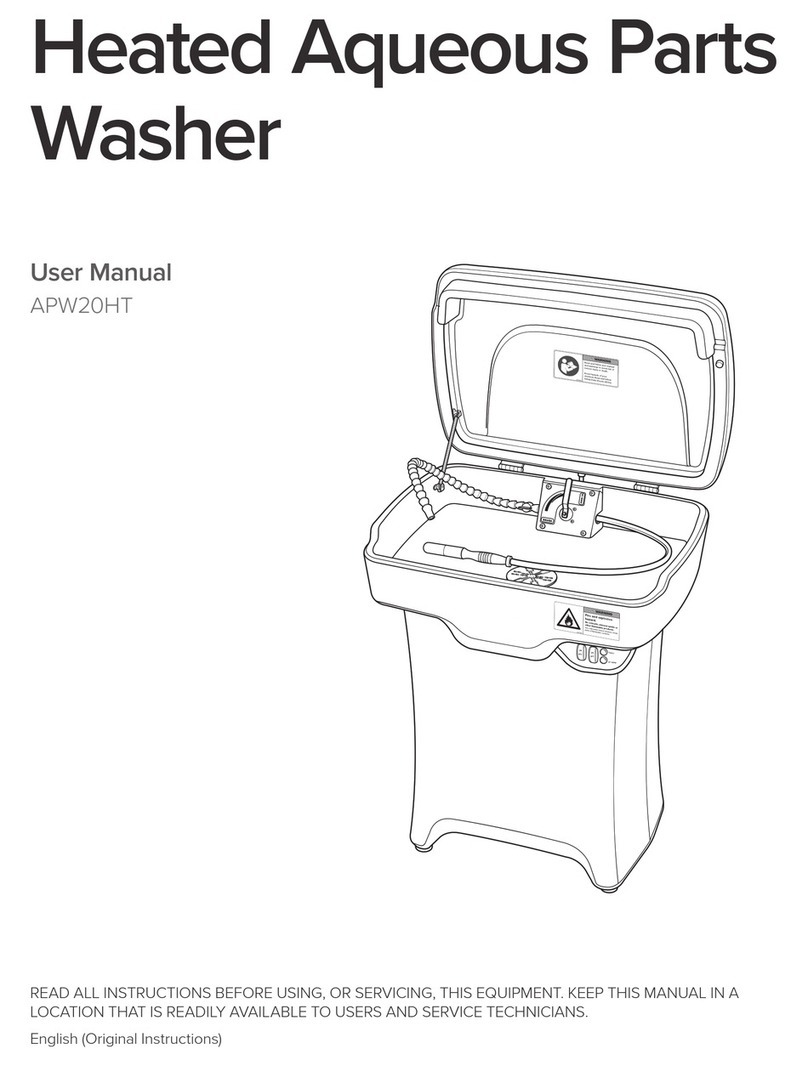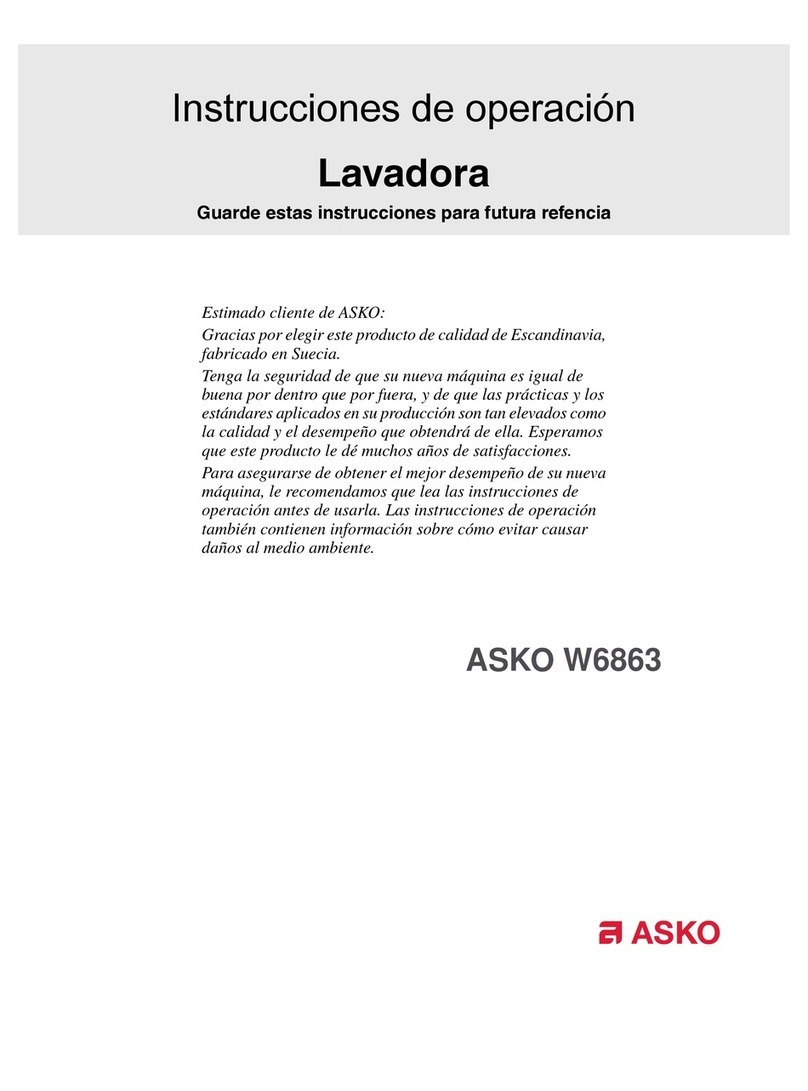BELIMED CS 720 User manual

Service Manual
CS 720/721
Manual Cartwasher
Rev. 1.1
Art. No. 300636 Operating, Diagnosis, Technical
and Schematic Manual
©Copyright Belimed Inc.
CS 720 Service Manual Revision 1.1 Page 1

Table of Contents
1. INTRODUCTION........................................................................................................................................5
1.1 COPYRIGHT NOTICE ................................................................................................................................5
1.2 EXPLANATION OF SYMBOLS....................................................................................................................5
1.2.1 Caution Symbol...............................................................................................................................5
1.2.2 Attention Symbol.............................................................................................................................5
1.3 GENERAL INFORMATION .........................................................................................................................6
1.3.1 General Precaution ........................................................................................................................6
1.3.2 Description of the Belimed CS720..................................................................................................6
1.3.3 Design Features..............................................................................................................................7
1.4 INTENDED USE ........................................................................................................................................9
1.5 DIMENSIONS............................................................................................................................................9
2. SAFETY PRECAUTIONS ..........................................................................................................................2
3. TECHNICAL DATA....................................................................................................................................4
3.1 UTILITY REQUIREMENTS.........................................................................................................................4
3.2 UTILITY CONNECTIONS ...........................................................................................................................4
3.2.1 Electric Supply................................................................................................................................4
3.2.2 Compressed Air ..............................................................................................................................5
3.2.3 Steam ..............................................................................................................................................5
3.2.4 Drain...............................................................................................................................................5
3.2.5 Exhaust...........................................................................................................................................5
3.2.6 Water ..............................................................................................................................................6
3.3 EMISSIONS...............................................................................................................................................7
4. INSTALLATION .........................................................................................................................................8
4.1 INTRODUCTION........................................................................................................................................8
4.2 INSTALLATION DRAWING........................................................................................................................8
4.3 INSTALLATION CONSIDERATIONS............................................................................................................8
4.3.1 Loading Dock .................................................................................................................................8
4.3.2 Space Considerations .....................................................................................................................8
4.3.3 Service Power Outlet......................................................................................................................8
5. GENERAL DESCRIPTION OF THE COMPONENTS AND FUNCTIONS ........................................9
5.1 OVERVIEW ..............................................................................................................................................9
5.2 INDICATORS AND GAUGES.....................................................................................................................10
5.3 OPERATING CONTROL PANEL................................................................................................................10
5.4 EMERGENCY STOP BUTTONS.................................................................................................................11
5.5 CHEMICAL DOSING UNIT.......................................................................................................................12
5.6 DOOR OPERATION.................................................................................................................................12
CS 720 Service Manual Revision 1.1 Page 2

6. OPERATION..............................................................................................................................................13
6.1 GENERAL PRECAUTIONS .......................................................................................................................13
6.2 TURNING ON THE MACHINE ..................................................................................................................13
6.3 PROGRAM READY..................................................................................................................................14
6.4 DESCRIPTION OF OPERATION.................................................................................................................15
6.4.1 Wash Chamber .............................................................................................................................15
6.4.2 Doors............................................................................................................................................16
6.5 PROGRAM SELECTION ...........................................................................................................................18
6.5.1 Factory Pre-set Programs............................................................................................................18
6.5.2 User Defined Settings...................................................................................................................18
6.6 SETTING THE PROGRAM PARAMETERS ..................................................................................................19
6.7 LOADING AND UNLOADING...................................................................................................................19
7. FAULTS – INTERVENTION AND RESOLUTION..............................................................................20
7.1 WASH CHAMBER FAULTS......................................................................................................................20
7.1.1 Spray Ring Blocked. .....................................................................................................................20
7.1.2 DS Door........................................................................................................................................21
7.1.3 CS Door........................................................................................................................................21
7.1.4 Fault - Tank not filling..................................................................................................................22
7.1.5 Supply Tank not heating ...............................................................................................................22
7.1.6 Fault –No Water pressure ............................................................................................................23
7.1.7 Fault – Emergency Stop?..............................................................................................................23
7.1.8 Fault? ...........................................................................................................................................23
8. MAINTENANCE .......................................................................................................................................24
8.1 DAILY MAINTENANCE...........................................................................................................................24
8.1.1 Utility Room..................................................................................................................................24
8.1.2 Decontam and Clean Room..........................................................................................................24
8.1.3 Wash Chamber .............................................................................................................................24
8.2 WEEKLY MAINTENANCE.......................................................................................................................25
8.2.1 Utility Room..................................................................................................................................25
8.2.2 Chamber.......................................................................................................................................25
8.3 MONTHLY MAINTENANCE.....................................................................................................................25
8.3.1 Utility Room..................................................................................................................................25
8.3.2 Door Seals....................................................................................................................................26
8.3.3 Chamber.......................................................................................................................................26
9. PARTS LIST...............................................................................................................................................27
9.1 ELECTRICAL CABINET...........................................................................................................................28
9.2 PNEUMATIC MANIFOLD.........................................................................................................................30
9.3 LIFTING FLAPS (DS AND CS) ................................................................................................................32
9.4 DOOR MECHANISM (DS AND CS)..........................................................................................................34
9.5 DOOR OPERATOR ..................................................................................................................................36
CS 720 Service Manual Revision 1.1 Page 3

9.6 TILT MECHANISM (WASH AND DRYING)...............................................................................................38
9.7 CHAMBER LIGHTING .............................................................................................................................40
9.8 WASH CHAMBER...................................................................................................................................42
9.8.1 Chamber Screens..........................................................................................................................44
9.8.2 Exhaust Fan..................................................................................................................................46
9.8.3 Spray Ring....................................................................................................................................48
9.8.4 Hoist Mechanism..........................................................................................................................50
9.9 WASH AND RINSE SUPPLY TANKS.........................................................................................................52
10. DIAGRAMS............................................................................................................................................54
CS 720 Service Manual Revision 1.1 Page 4

1. Introduction
1.1 Copyright Notice
Copyright © 2004, Belimed Inc.
All Rights Reserved.
Any technical documentation that is made available by Belimed, is the copyrighted work of
Belimed, and is owned by Belimed.
Belimed has made every effort to ensure the accuracy of the information provided in this manual.
Any use of the technical documentation or the information contained therein is at the risk of the
user. Documentation may include technical or other inaccuracies or typographical errors. Belimed
reserves the right to make changes without prior notice.
No part of this publication may be copied and/or distributed to individuals or entities other than the
original equipment owners without the express written permission of Belimed.
13840 S. W. 119th Ave., Miami, FL 33186-6006.
1.2 Explanation of Symbols
Throughout this manual one or more of the following symbols may be found. They have been
placed to bring attention to the areas of the manual which may cause harm or damage to
individuals or the machine if proper safety procedures are not followed. Proper safety procedures
should be followed at all times while working on the equipment.
!
1.2.1 Caution Symbol
In this manual you will find this symbol in connection with all safety
directions in which body and life of persons could be in danger. Follow
the rules and especially carefully in these cases. Pass on these safety
directions to other users. Apart from the directions in this manual, the
generally accepted rules of safety and prevention of accidents must
be observed.
1.2.2 Attention Symbol
This symbol will be found in this manual when it is important to
emphasize that rules, procedures, directions and the correct
sequence of working steps are to be followed to prevent damage
and destruction of the machine.
ATTENTION
CS 720 Service Manual Revision 1.1 Page 5

1.3 General Information
1.3.1 General Precaution
Please read this manual carefully before setting up the machine.
Only personnel who read the operating instructions and safety
precautions should operate, maintain or repair the machine.
ATTENTION
No liability will be accepted in respect of damage occurring to the machine by non-
compliance with these instructions. These instructions only refer to this Belimed CS 720
machine. Belimed reserves the right to make technical changes, which improve the
operation, maintenance or safety of the equipment.
1.3.2 Description of the Belimed CS720
The Belimed CS720 is a single chamber machine. The washing and drying chamber is
constructed primarily of polished stainless steel. All interior panels and components are
stainless steel and are well insulated with 1.5” of fiberglass insulation. Each panel is
covered with a steel panel on the exterior to protect the insulating material and reduce
unwanted noise. The wall sections transfer heat at the rate of 8,200 BTUs at the chamber
sides. All associated hardware to attach the panels and other structures are stainless steel.
All welds on the chamber and other components are dressed and polished to a matched
finish. Each cartwasher has a tilt mechanism installed to allow for liquid draining during the
wash, rinse and dry cycles. All components that can be harmed by the chamber
environment are mounted to the exterior of the chamber. Mounted in the top of the chamber
is a glass window for illumination of the chamber. A light is mounted on the exterior away
from harmful vapors and shines through the window. The Supply cabinet mounted to the
exterior chamber wall, in the supply room, houses all the electrical components and
process control unit needed to operate the Belimed CS 720.
The Belimed CS 720 is installed between the clean and the unclean sides in a 5” pit to
allow for loading level with the finished floor.
The Belimed CS 720 is equipped with two pairs of bi-folding doors. One each at the load
and unload ends of the chamber. All doors are constructed of polished stainless steel inside
and out. They are fitted with rigid foam insulation between the panels and welded together
to form a sealed door. The doors effectively control heat transfer to 2,800 BTUs at the
entrance and exit. Each bi-folding section contains a 7.5” round window of tempered glass
for clear visibility through the washer. Attached stainless steel shafts and a guide track
mounted to the chamber, guides the door’s leading edge. The doors are opened and closed
via a pneumatic piston. The piston rotates a solid 1” shaft at the exterior of the chamber,
which is mounted vertically through the entire door and protrudes through to the exterior of
the chamber. The door’s opening and closing are controlled by the process control. Care
CS 720 Service Manual Revision 1.1 Page 6

has been taken to ensure that only one door can be opened at any one time In accordance
with Hospital guidelines as published in “Guidelines for Design and Construction of
Hospitals”. This publication states that the Decontam room shall be physically separated
from all other areas of the department. If the doors remain open, cross contamination is
allowed and the airflow balance is disrupted. If any of the folding doors are not tightly
closed, the process control will prevent the start of a program.
1.3.3 Design Features
Chamber Design: The Stainless Steel pan is self-supported without seams to protect
against leaks. The roof is designed as a ridged structure to support the additional
components. The stainless steel ceiling is pitched to avoid accumulation of water droplets.
External surfaces, roof and sides, are insulated with fiberglass and covered with galvanized
steel sheeting.
Supply Tank: This separate unit consists of a tank, insulated on all sides and a circulation
pump made of stainless steel. The wash water is heated inside the supply tank by a steam
coil and control valve. A built in overflow skims the surface water as it is returned during
the wash and rinse cycles.
Rinse Heat Exchanger: The rinse water is heated inside the tubular heat exchanger by a
steam coil and control valve. Hot water passes through the heat exchanger during the rinse
cycle to super heat the loaded carts and rinse away residues from cleaning.
Liquid Return Pump: A self-priming vertical pump made of stainless steel allows a rapid and
complete return of the washing liquid and rinse liquids out of the chamber and back to the
supply tank for re-circulation
Spray Ring: The spray ring consists of 2 rings provided with spray nozzles. The bottom ring
for washing and the upper ring for rinsing. The spray ring moves in a vertical direction. The
lift of the spray ring and the number of repetitions (one complete down and up of the ring)
for both washing and rinsing is adjustable. The Lift of the spray ring is determined by the
height of the carts to be washed. For example:
Medium Cart
position 2
Low Cart
p
osition 1
Tall Cart
position 3
CS 720 Service Manual Revision 1.1 Page 7

The motor for the spray ring is located on the chamber ceiling. If the spraying frame gets
blocked in its upward or downward movement a safety switch stops the movement of the
spray ring to prevent damage to carts.
Chemical Dosing Unit: The Belimed CS 720 is equipped with two chemical additive pumps
that are located in the supply room and draw chemical through a poly-braid hose to the
pump and then eject the chemical under pressure into the supply tank and rinse water. The
chemical pumps are equipped with low-level sensors for the chemical additive. When the
chemical additive is low the status will be displayed at the master control. The pumps can
be adjusted directly at the pump and controlled further by timers in the process control
software.
Pneumatic Unit: All the valves and regulators required for the pneumatic operation of the
machine are mounted on a manifold that is easily accessible. The valves can be controlled
manually at the valve and electronically through the service mode.
Exhaust Equipment: The air exchange within the chamber is carried out by a radial exhaust
fan on the chamber ceiling. The fan has two operating speeds. The fan draws out excess
vapors during the wash and rinse steps and maintains negative pressure within the
chamber at low speed. In the dry step air is drawn in across a air heat exchanger to dry the
carts. The removal of all vapors is accomplished before program completion.
Tilt Mechanism: By means of pneumatically driven cylinders mounted on the chamber roof
the traveling rail pallet can be brought into an inclined position during both wash and dry
programs. The inclined position prevents formation of water puddles on flat cart surfaces
and increases the drying effect.
Process control:
Stored-program control
8 megabytes flash memory
Handling time 2.5 ms
RS 485 / RS 232 - user interface
Safety switching (cycle monitor in case of programs fault)
80 inputs/76 outputs
3 factory stored wash and disinfecting programs
Service Mode for checking the inputs and outputs
Adjustable programs by means of the touch-screen
System Cycle Counter
640 x 480 pixel touch-screen
Program Indication
Fault indication
CS 720 Service Manual Revision 1.1 Page 8

1.4 Intended Use
The Belimed CS 720 is designed for the washing of, transport carts, case
carts and the like. Any other usage is not recommended.
!
Belimed will not warrant for any damage resulting from misuse; this risk is the responsibility of the
user.
The Belimed CS 720 is designed to automatically wash, rinse, and dry a variety of different carts.
The Belimed CS 720 has been carefully designed to last for a period of twelve years or longer
without the need for major renovation or modification. With proper maintenance, the Belimed CS
720 is a reliable tool in the decontamination process.
1.5 Dimensions
Minimum Clearance Height: 114” / 126”
Minimum Pit Depth: 5”
Model 160/175 160/200 230/175 230/200 270/175 270/200
Net Usable Length 63.0” 63.0” 90.0” 90.0” 106.0” 106.0”
Net Usable Height 69.5” 78.75” 69.5” 78.75” 69.5” 78.75”
Net Usable Width 39.40” 39.40” 39.40” 39.40” 39.40” 39.40”
CS 720 Service Manual Revision 1.1 Page 9

!
2. Safety Precautions
•BURN AND SHOCK HAZARD: Repairs and adjustments should be
attempted only by authorized persons fully acquainted with this equipment.
Use of inexperienced, unqualified persons to work on the equipment or the
installation of unauthorized parts could cause personal injury or result in
costly damage.
•Observe the dangerous voltage labels. Switch off power to machine before opening
electrical cabinets.
•BURN HAZARD: Allow the machine and its accessories to cool to room temperature before
performing any cleaning or maintenance procedures.
•This machine is NOT DESIGNED TO PROCESS APARATUS CONTAINING FLAMMABLE
LIQUIDS.
•BURN HAZARD: All Goods coming out of the dryer will be HOT TO THE TOUCH.Wear
gloves if a cart is to be handled right away.
•BURN HAZARD: Exercise extreme caution when crawling on top of the machine. Steam
piping might be exposed and burn you. Also the stainless steel ducting might be hot and
can burn you.
•BURN HAZARD: Holding tanks piping and piping alongside machine are hot and can burn
you. Exercise care when walking around tanks.
•FALL HAZARD: To prevent falls, keep floors dry around machine in both Clean and
Decontam rooms.
•FALL HAZARD: Exercise extreme care when going on top of the machine to perform
maintenance. The area is restrictive and it is very easy to loose your balance.
•EXTRANGULATION HAZARD: Avoid wearing loose clothing like ties when going on top of
the machine as there are moving parts that can hurt you.
•BODILY INJURY: Use of the machine should be restricted to properly trained personnel.
CS 720 Service Manual Revision 1.1 Page 2

•Never use wire brushes or steel wool on doors and chamber assembly.
ATTENTION
•Solenoid valves are equipped with a special material, which can be attacked by oils,
grease and moisture. When replacing solenoid valves, wipe mounting surfaces clean of
oils and use Teflon tape to seal pipe joints.
•Keep the loading and unloading areas free from obstruction while unit is operating.
•Any alteration of the machine, which affects its operation, will void the warranty and could
violate state and local regulations.
•Use only original BELIMED replacement parts for maintenance purposes.
•Do not use sharp pointy objects to activate the touch screen, serious damage can occur to
the touch screen and it will void its warranty.
CS 720 Service Manual Revision 1.1 Page 3

3. Technical Data
3.1 Utility Requirements
Steam connection at the wash liquid tank: 1.0”
Steam connection at heat exchanger: 1.0”
Steam operating pressure: 40-70 PSIG
Steam consumption: (per load) 19 lbs.
Steam Consumption: (per liquid change) 70.5 lbs.
Condensate connection: 3/4”
Compressed Air connection: 1/2"
Compressed Air operating pressure: 100 PSIG
Compressed Air consumption: (per load) less than 10 CU. FT.
Compressed Air Flow Capacity 25 CFM
Electric connection: 208 V, 60 Hz
Circuit Protection: 50 A
Exhaust air connection: 8” diameter
Relative Exhaust Humidity: 100%
Water (softened) Connection: 3/4”
Water operating pressure: 30-75 PSIG
Water consumption: (per load) ~9.5 gallons
Water consumption: (per liquid change) 92 gallons
Water flow-rate: min. 8 GPM
Drain Connection: 2”
!
3.2 Utility Connections
Belimed provides an Installation drawing with specific locations for each
supply and its associated requirements. Care should be taken to review the
demands of all supplies listed on your site specific installation drawing.
3.2.1 Electric Supply
The electric supply connection is located on the control panel. The electrical service should
comply with the local building code and be installed accordingly. A service disconnect
should be installed within the supply room to avoid feeding power directly to the Belimed
CS 720.
CS 720 Service Manual Revision 1.1 Page 4

3.2.2 Compressed Air
The pneumatic connection is located on the maintenance unit below the electric control
panel.
The Belimed CS 720 is equipped with a complete manifold assembly containing the
regulator and moisture separator. It is the responsibility of the customer to provide air that is
free from oils, water and impurities, which can harm the control valves.
3.2.3 Steam
There are three Steam connection points, one each at the Supply Tank, Rinse Tank and
the Air Heat Exchanger.
Steam is required to heat the water used in the machine. Wash water is heated in the
supply tank and rinse water is heated within a tube bundle type heat exchanger. Steam is
also required to heat the air for drying.
It is the responsibility of the customer to provide dry steam free from solid particles
and de-watering traps prior to the machine connection point.
The steam is piped into stainless steel coils located in the machine supply tank, air heat
exchanger and the rinse supply tank. Condensate is returned to the building supply through
a steam trap located at the outlet of the machine steam coils. No live steam enters the
machine. The heat transfer from the steam coil to the surrounding water and/or air in the
heat exchangers accomplishes heating of the water and air.
Proper functioning of the steam heating system is essential for proper operation of the
Belimed CS 720.
3.2.4 Drain
Good drainage is essential for proper operation of the machine. The drain connection size
for the machine is 2". The machine circuitry is designed for very rapid draining of the sump
contents through a 2" valve. The building drain should incorporate its own trap or siphon for
odor control and to comply with local code and be of a diameter larger than 2”.
3.2.5 Exhaust
CS 720 Service Manual Revision 1.1 Page 5

In the Belimed CS 720 Washing and Rinsing and Drying are accomplished in the same
chamber.
During the washing and rinsing cycles (1 to 2 minute duration for most wash programs)
vapor will form as the water temperature rises (maximum design temperature = 200 °F or
93 °C). The exhaust fan runs at low speed and draws the vapors out of the chamber and
into the exhaust vent and attached ducting. Depending on duct environmental conditions
(air temperature, air velocity, and relative humidity) some of these vapors will condense in
the exhaust ducting.
To prevent leakage of condensate out of duct joints, proper ducting and sealing techniques
must be complied with. Horizontal runs of duct directly from the machine should be pitched
back to the machine to allow potential condensate to drain back. The machine is furnished
with an exhaust condensate line that will remove condensate under most conditions. Its
design features an 8” stainless steel exhaust pipe outlet, which must be adapted to a 10"
pipe, such that condensate that forms due to the diameter expansion can drain into a 3/8"
nipple, which is connected by tubing to the machine drain. Recommended ducting
materials are stainless steel, polyethylene or galvanized steel pipe. Aluminum is not
recommended for the first few feet prior to connection into larger ducts carrying additional
air, because of possible pitting and sealing problems.
During the drying phase (8 to 12 minutes duration for most wash programs) the exhaust fan
runs at high speed. The incoming air is suctioned through intake channels, and across a
steam powered heating element and into the machine chamber, then across the washed
goods.
3.2.6 Water
The Belimed CS 720 is equipped with two water solenoid valves. It is the responsibility of
the customer to install service valves, back flow and fine particle strainers in each water
connection. Belimed only provides the automatic on/off valve controlled by the Belimed CS
720. Fine strainers are required to prevent the lodging of small solids in the orifice of the
water solenoid valves and thus decrease the water flow rate or render the solenoid valve
non-functional. Small solids lodged in the solenoid valve orifices prevent proper closing of
the solenoid valve and can thus lead to overflow of the machine and flooding. Belimed
makes available for sale water strainers with see-through indicators to show any trapped
solids and to indicate the need for cleaning. Water is used to wash and rinse in all cycles.
Hot water contributes to faster program cycles because it reduces the time needed for the
machine heater to pre-heat the water. It is required that water be softened to bring its
hardness below 90 ppm = 5 grains/gal.
Hardness in wash water (usually in form of calcium and magnesium) affects performance
in two ways:
CS 720 Service Manual Revision 1.1 Page 6

1. It requires considerably more detergent, since much of the detergent is used to neutralize
the water hardness and thus not available for cleaning.
2. Water hardness tends to chemically change with heat such that it becomes non-soluble
in water and thus deposits on the interior walls of the wash chamber and on the heating
coils (i.e. "tea kettle effect"), which impair the heating and drying capabilities of the
machine.
3.3 Emissions
Noise Level: max. 70dB (outside mechanical room)
Heat Radiation in Mechanical Room: 8,200 BTU/hr
Heat Radiation at Entrance: 2,800 BTU/hr
Heat Radiation at Exit: 2,800 BTU/hr
Total BTU: 13,800 BTU/hr
Exhaust, during Wash: max. 250 SCFM
Exhaust, during Dry: max. 820 SCFM
Exhaust Air Temperature: max. 120°C
All above based on factory settings.
CS 720 Service Manual Revision 1.1 Page 7

4. Installation
4.1 Introduction
Installation of the Belimed CS 720 must be performed by Belimed Technicians as they have
received detailed training on all aspects of the installation, assembly, and maintenance of the
Belimed CS 720. Belimed is involved in every installation in order to be able to insure the
warranty of the system for the accepted duration.
4.2 Installation Drawing
Belimed provides each customer an installation drawing for each project. The Installation drawing
should be used to prepare the site in advance of the installation date. The Installation drawing will
show any necessary modifications to an existing site and specify the final location of all utilities as
required by the Belimed CS 720.
4.3 Installation Considerations
4.3.1 Loading Dock
During the unloading process it will be necessary to park a 20’ container at the loading dock
for approximately 4 hours. The loading dock needs to be of level height with a normal
delivery truck. If a loading dock is not available, a forklift must be provided.
4.3.2 Space Considerations
A clear path from the loading dock to the installation site is required to move the
components. The largest piece is 6”x63”x99.5”. Please confirm a safe route is available for
this item.
If the unit is not going to be assembled at the time it is delivered then ample storage space
for the equipment must be provided. The minimum storage area required is 150 square feet
and should contain a minimum of 33 linear feet of wall space. This area will also be used as
a staging area during the installation.
4.3.3 Service Power Outlet
One convenience outlet (110/120V) is required for installation and servicing of the
equipment and the use of power tools.
CS 720 Service Manual Revision 1.1 Page 8

5. General description of the components and functions
5.1 Overview
Figure 5-1 shows the main components or control elements that are accessible to the user from
the Decontam side or entrance of the unit. The control panel is mounted in the enclosure near the
Decontam side door.
Figure 5-2 shows the main components and control elements that are accessible from the Clean
Side or exit of the unit.
Insert picture, Isometric view of front of CS 720.
Arrows pointing to control panel, door, EMO
TO BE INSERTED AFTER INSTALLATION
Insert picture, Isometric view of clean side of CS 720.
Arrows pointing to control panel, door, EMO
TO BE INSERTED AFTER INSTALLATION
CS 720 Service Manual Revision 1.1 Page 9

5.2 Indicators and Gauges
The process control indicators are located within the display on the control panel. Scrolling
through the appropriate screens allows access to the various indicator readings.
The service gauges are all located within the supply room area.
5.3 Operating Control Panel
All functions and the testing of the inputs and outputs can be accessed from the control panel.
The control panel has a color touch-screen, size 117mm x 90 mm (4.6” x 3.5”), 320 x 240 pixels,
that displays context sensitive screens with context sensitive buttons, as well as a lower line
showing a multi-colored cube and date and time. The screen displays along with the button
values, descriptions and their functions are described further through out this section.
There is a multi-colored cube in the lower left corner of the screen that is displayed at all times,
along with the date and time.
Pressing the multi-colored cube will bring up three additional buttons in the same row, the
function of which is as follows:
SYSTEM: Set system date and time (see section xxx)
HELP: Brings up context sensitive electrical schematics
MENU See below.
All other buttons are not used!
Touching the MENU button brings up a choice of buttons.
Touching “Passwords” allows someone to access the service menu by entering a password.???
All other buttons are not used!
CS 720 Service Manual Revision 1.1 Page 10

5.4 Emergency Stop Buttons
There is a number of large emergency stop buttons mounted throughout the Belimed CS 720.
These buttons are for protection. Activation of any one of these switches will deactivate certain
components as described below and cause the appropriate “FAULT – EMERGENCY STOP”
screen to come up on the main display. The Emergency Stop Switch that was pushed will need to
be reset before the machine can resume activity.
CS 720 Service Manual Revision 1.1 Page 11

The Belimed CS 720 is equipped with 4 Emergency Stop Buttons. They are described as
follows:
1. Main Control Panel (DS Door) (1 each):
2. Inside Wash/Dry Chamber (2 each):
3. CS Door Control Panel (1 each):
Pressing any one of these switches will deactivate the following components:
All Doors: De-energized
Main Wash Pump: De-energized
Spray Ring Motor: De-energized
Dryer Fan/Heater: De-energized
5.5 Chemical Dosing Unit
The Belimed CS 720 is equipped with two chemical additive pumps that are located in the supply
room and draw chemical through a poly-braid hose to the pump and eject the chemical under
pressure into the supply tank and rinse water. The Chemical pumps are equipped with a low-level
sensor for the chemical additive. When the chemical additive is low an audible alarm will sound
and status will be displayed at the master control. The pumps can be adjusted directly at the
pump and controlled further by timers in the process control software.
5.6 Door Operation
The Belimed CS 720 has two bi-folding door sections. One each at the entrance, and exit of the
washer. The door functions are controlled primarily by the process control. In SERVICE mode the
door functions can be accessed from the control panel.
CS 720 Service Manual Revision 1.1 Page 12
This manual suits for next models
1
Table of contents
Other BELIMED Washer manuals



